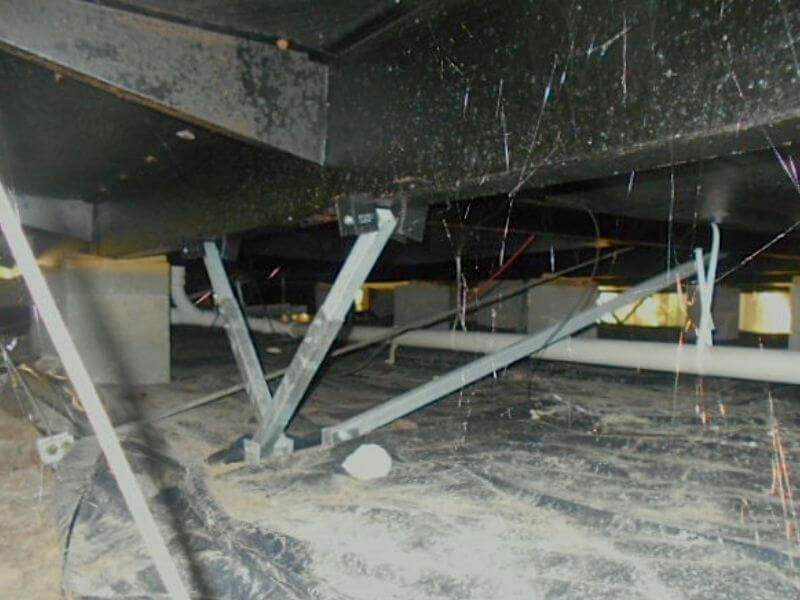A question that often arises with mobile homeowners is whether or not they need to install a vapor barrier under their mobile home.
This is an important question, as the installation of a vapor barrier can create significant energy savings for your home by preventing moisture from accumulating in the sub-flooring and walls of your mobile home.
However, it also has some drawbacks
- Firstly, you have to remove any existing floors before installing the barrier.
- Secondly, if you are installing new flooring after the installation of the Vapor Barrier then this will cause water damage during heavy rainfall or snowmelt because there will be no way for excess water to drain off your property.
- And thirdly, if you are planning on moving soon, then removing any installed Vapor Barrier might be difficult without damaging
Vapor barriers are necessary when moisture or humidity is present and not properly controlled.
When there is too much vapor in the air, it will cause problems with wood and drywall. Moisture can also soak into insulation and create mold and mildew problems as well as odors.
When you choose the insulation for walls, ceilings and floors of your mobile home, make sure to select a product that has been treated for impermeability (vapor barrier).
If no such treatment exists, you must purchase a vapor barrier (3-mil polyethene sheet) separately from an exterior wall finish like drywall or paneling.
How do I know if I need a vapor barrier?

A vapor barrier is usually installed under the sub-floor and between the insulation and the floor.
If you notice that water accumulates on your mobile home or condensation forms on any of your windows, then it’s an indication that moisture is entering the insulation and walls of your mobile home.
Maintaining a dry interior environment in your mobile home will help keep it in good condition longer, providing more years of service for you.
Carefully read labels and manufacturer instructions when choosing new products for insulating your mobile home to make sure they are rated as impermeable (vapor barriers).
Another sign that you may need to install a vapor barrier is if there is mold or mildew growth on or around wall plates, moldings and other wooden components inside your mobile home.
If you need to install a vapor barrier, then get the proper materials and carefully follow the instructions making sure that it is sealed properly.
Also Read: How Often Should You Relevel A Mobile Home?
How much is a vapor barrier for a mobile home?
Vapor barriers for mobile homes are specifically made with an impermeable material to make sure moisture is not able to pass through them.
You can purchase this product online or at your local home improvement store.
An example of a vapor barrier is 3-mil polyethene sheeting, which you should be able to get from any home improvement retailer such as Home Depot or Lowe’s. They should provide all the necessities such as glue and tape so that you can seal it properly against the walls and floor of your mobile home.
It typically costs between $50-$200 depending on the size and type of insulation that you need to install in your mobile home.
What else do I need when installing a vapor barrier?
When installing a vapor barrier, you will also need to purchase something called “vapor retarder” which will help to keep the moisture from occurring.
Helpful Article: How To Deodorize A Mobile Home?
You may want to install it on the walls, subfloor and roof of your mobile home depending on where it is located.
You must know that there are different types of permeability like impermeable (vapor barriers) or semi-permeable (foil-faced insulation).
A vapor retarder is used in conjunction with an air/moisture barrier under your sub-flooring and between your subfloor and insulation as well as other components inside the walls of your mobile home like wood flooring or paneling.
Where are vapor barriers required?
Vapor barriers are used in the mobile home industry to control moisture and humidity levels under the sub-floor. It can also be installed underneath walls or between the insulation and the floor of your mobile home.
Moisture control is necessary when houses are built to standards that call for vapor barriers to prevent condensation from forming on windows or mold and mildew growth on surfaces within your mobile home.
Conclusion
Vapor barriers are used to help maintain the insulation and airtight qualities of a home. If you live in an area with high humidity, extreme weather conditions or ground-based moisture issues, it is recommended that you install vapor barrier under your mobile home.
If not, it might make sense for you to skip the expense altogether since these systems can cost anywhere from $1 per square foot upwards of $3 per square foot depending on how much work needs to go into installing them correctly.

